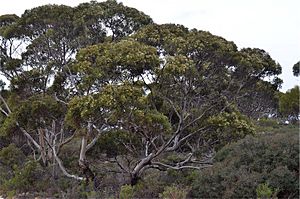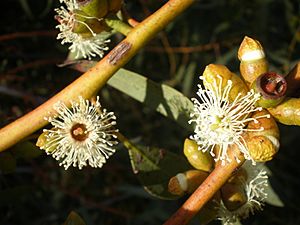Yorrell facts for kids
Quick facts for kids Yorrell |
|
|---|---|
 |
|
| E. gracilis in the Lincoln National Park | |
| Scientific classification | |
| Genus: |
Eucalyptus
|
| Species: |
gracilis
|
The Eucalyptus gracilis, often called yorrell or white mallee, is a special type of tree or shrub. It grows only in Australia, mainly in New South Wales, Victoria, South Australia, and Western Australia. This plant usually has smooth, white bark, but its lower stems might have rough, flaky bark. Its leaves are long and narrow, and its flowers grow in groups of seven to eleven. The fruit looks like a cup, cylinder, or barrel.

Contents
What Does the Yorrell Look Like?
The yorrell is a type of mallee, which means it's a shrub or small tree with many stems growing from the ground. It usually grows up to 7 meters (about 23 feet) tall, but sometimes it can reach 20 meters (about 65 feet).
Bark and Leaves
The bark of the yorrell is smooth and can be white, grey, or a coppery-cream color. However, the bark at the bottom of its stems is often rough or flaky.
Young plants and new shoots (called coppice regrowth) have long, narrow leaves. These leaves are usually 33 to 90 millimeters (about 1.3 to 3.5 inches) long and 9 to 18 millimeters (about 0.35 to 0.7 inches) wide.
Adult leaves grow in an alternating pattern along the stem. They are shiny green on both sides. These leaves are also long and narrow, or slightly curved. They measure 45 to 110 millimeters (about 1.8 to 4.3 inches) long and 4 to 17 millimeters (about 0.16 to 0.67 inches) wide. Each leaf has a short stalk, called a petiole, which is 5 to 15 millimeters (about 0.2 to 0.6 inches) long.
Flowers and Fruit
The flower buds of the yorrell grow in groups of seven, nine, or eleven. These groups are on a stalk called a peduncle, which is 5 to 15 millimeters long and has a square shape. Each individual bud has its own tiny stalk, called a pedicel, about 2 to 5 millimeters long.
When the buds are ready to open, they look like clubs. They are 3 to 7 millimeters long and 3 to 5 millimeters wide. The top part of the bud, which covers the flower, is called an operculum. It is usually flat or rounded.
Yorrell trees bloom between March and October, producing creamy-white flowers. After the flowers, the tree grows fruit. This fruit is a woody capsule that looks like a cup, cylinder, or barrel. It is 4 to 8 millimeters long and 3 to 7 millimeters wide. The parts that open to release the seeds are tucked inside the fruit.
Where Does the Yorrell Grow?
The yorrell tree grows in many parts of Australia. You can find it on sand dunes, flat plains, on top of small hills, and along creek beds.
Locations in Australia
In Western Australia, it grows in sandy-clay-loamy soils, often over limestone. In South Australia, it is common throughout the southern and central areas. Here, it grows in mallee shrubland in various soil types, also often over limestone. In Victoria, it is found only in the northwest part of the state, mostly in the Big Desert and Sunset Country, extending east to Manangatang. It also grows in southwestern New South Wales. There, it is found in mallee shrubland on red sandy soils, south from Yathong and west from West Wyalong.
How Is Yorrell Used?
Eucalyptus gracilis is a useful plant that people often grow for different reasons.
Cultivation and Benefits
It is commonly planted in open areas, wide road verges, parks, and nature reserves. People also use it as a windbreak to protect other plants or buildings from strong winds. It helps control erosion by holding the soil in place with its roots.
The yorrell is also known to be good for honey production, as its flowers provide nectar for bees. Many nectar-eating birds and insects use the yorrell for food and as a place to live. For example, the yellow-tailed black cockatoo eats the seeds from this tree.
Images for kids
-
Mallees near Calperum, South Australia




